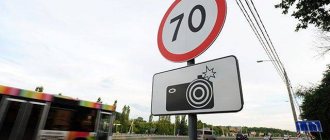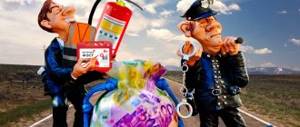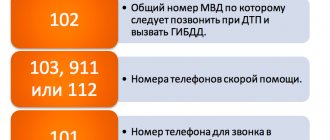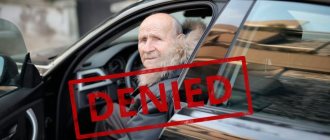Railroad crossings are considered areas of increased danger for road users. Therefore, liability for violating the rules for traveling through them will be strict. For violations committed by drivers in this case, fines may be imposed, and sometimes the driver’s license will be confiscated.
The increased severity of punishments is provided because when driving through particularly dangerous areas, the person behind the wheel endangers not only his life and health, but also poses a threat to other road users.
Fines and/or other penalties
It is strictly forbidden to stop vehicles at railway crossings.
Stopping at a crossing is punishable by a fine - the amount is 1000 rubles according to the rules of the Administrative Code, Article 12.10, part one. A decision may also be made to punish the driver by depriving him of the right to drive a car for a period of 3-6 months (Article 12.10, Part 3).
If the violation occurs again, the offender may be disqualified from driving for one year.
They can be punished in cases where the car was stopped at any section of the crossing, except for specially designated places - the area of the stop line, the STOP sign, in front of the barrier. Having stopped in this area, the driver must assess the situation in order to avoid mistakes when crossing a high-risk zone.
For example, immediately after a crossing, a traffic jam of several cars may accumulate, due to which you will have to slow down on the railway tracks. By stopping at the stop line, you can notice the congestion in advance and avoid driving onto the tracks.
Travel without stopping
If the driver drove in the required place without making a mandatory stop in front of him, this is a violation. The sign “No driving without stopping” obliges you to stop even when the road is empty. If there is no white stop line, you must brake in front of the sign.
Violators of this rule will be fined - the amount is 1000 rubles.
Forced stop on the rails
If the driver was forced to stop at a crossing, no punishment will follow if it can be proven that the car stopped due to a breakdown.
The same is true in the case when the car in front suddenly stopped, which is why the next one had to brake. If your car breaks down and you are forced to stop, you must immediately take measures to ensure the safety of other road users:
- Passengers in a stopped car should be disembarked immediately.
- The driver must take all possible measures to clear the railway tracks as quickly as possible.
- If possible, people should be sent along the rails on both sides of the stopped car - they should move away about a kilometer and signal “Stop!” if they see an approaching train.
- Anyone who remains near the car will have to sound the horn. One long beep and three short beeps are a general alarm signal.
If you notice an approaching train, you need to add visible signals to the sound signals - make circular movements with your hand.
It is advisable to hold a clearly visible object in your hand, for example, a bright piece of fabric. At night, you should use a flashlight to signal.
Overtaking
Overtaking is a maneuver in which a car leaves its lane, gets ahead of other vehicles and returns to its original lane. When performing a maneuver, the overtaking vehicle increases speed. The maneuver of moving into the adjacent lane begins, then advance is performed, after which the car returns to the same lane from which it started.
Overtaking is prohibited at some sites, including railway crossings. It is also prohibited to overtake vehicles moving ahead at a distance of 100 meters before crossing.
For this violation, the following fines and penalties are provided:
- A fine of 5,000 rubles (Administrative Code, Art. 12.10).
- Deprivation of the offender's right to drive a car for a period of 4 months or six months.
- Repeated violation - the driver is deprived of his license for one year.
If overtaking was carried out without entering the oncoming lane, it is classified as overtaking. When drawing up the protocol, it must be indicated that at the crossing there were more than two lanes for traffic in one direction.
After the car passes the railroad tracks in a specially designated place, the zone where overtaking is prohibited is over. If there are no signs that prevent cars from overtaking on this section of roads, the maneuver can be performed freely without fear of penalties.
Procedure for stopping at a railway crossing
Article 12 of the traffic rules determines the general procedure for stopping and parking vehicles, and article 15 - the very movement of the vehicle through the crossing.
There are 2 types of transfers:
- Adjustment occurs using barriers;
- Moving without a barrier.
There are mandatory requirements for both types of moves.
So, when driving through an unregulated railway crossing, the driver must stop the car near the stop line or stop sign, make sure that further passage will be safe and continue driving.
Stopping at a controlled crossing occurs:
Dear reader! Didn't receive an answer to your question? Our expert lawyers work for you. It's absolutely free!
- Moscow ext 152
- St. Petersburg ext 152
- All regions ext 132 (Toll free)
- In front of a closed barrier;
- When there is a prohibitory traffic light;
- When passage is prohibited by the traffic controller on duty.
Intentional parking at the crossings themselves and at a distance of 50 meters before them is prohibited.
In the traffic rules there is a concept of a forced car stop, which can occur due to:
- Vehicle malfunctions;
- Dangerous goods being transported;
- Obstacles on the way of movement;
- Poor condition of the driver or passenger.
In the event of a forced stop of the vehicle on the deck, all passengers must be immediately released from it. After this, try to remove the car from the crossing. If this cannot be done quickly, you need several people to go on opposite sides along the tracks for a distance of about 1 kilometer and give signals to the train driver if he approaches. During the day, the signal will be a circular movement using a bright object, and at night, using a flashlight.
In any other situations, stopping at a railway crossing is prohibited. It is also forbidden to drive onto the railway platform if there is a traffic jam when leaving it.
Where is it prohibited?
To correctly determine where and how to stop at and near a crossing, you should refer to the traffic rules. For ease of understanding, the entire site can be divided into zones:
- From 100 meters to the rails or more - when driving, the same rules apply as on a simple road.
- 100 meters from the rails – may be limited by signs, the same rules apply as on roads without rails.
- 50 meters – parking of any vehicle is prohibited in this zone; the rule applies to the area on both sides. If necessary, you should stop before the crossing itself, near the stop line, together with which a sign is used, according to which movement without stopping is prohibited.
- In the area for traffic that crosses the rails, you should move without any stops.
If the car has passed the stop mark and then was forced to brake due to the prohibiting signal turning on, you cannot use reverse gear. This position of the car, according to Articles 12.10, 12.19 of the Code of Administrative Offences, is also subject to a fine.
The amount of the fine depends on how the violation is classified. The driver can try to mitigate the punishment by making a statement that the barrier was open and the traffic light was green.
Overtaking before a railway crossing
Before any railway crossing outside a populated area, regardless of whether it is equipped with a barrier or not, signs are installed that indicate the distance to the crossing .
A sign with three stripes is located 150 m from the crossing, with two stripes – 100 m , with one strip – 50 m . 100 m in front of the railway tracks , but advance is not prohibited .
In urban areas, crossings are equipped with other signs - a railway track sign ( 1.1 ) and a steam locomotive sign ( 1.2 ).
They are installed at a distance of 100 meters from the tracks. The same rule applies in the city - overtaking is prohibited 100 meters before the railway tracks.
It should be noted that advance can be performed at any distance from the crossing . Leading is considered to be a situation when the speed of the vehicle is higher than the speed of the passing vehicle . It can be with changing lanes and then returning to your lane , or changing lanes without subsequently returning to your lane.
Overtaking involves moving into oncoming traffic . Usually, you can easily navigate by the roadway markings when overtaking a passing vehicle is prohibited.
Detour - a car goes around a stationary obstacle (for example, a broken down car or a road service vehicle) and then returns to its lane. The following is prohibited at a railway crossing:
Administrative monetary penalty for overtaking at a railway crossing is 1,000 – 1,500 rubles .
Here you will find information about other fines for traffic violations.
Permitted places
The traffic rules also indicate the distance at which a driver who is about to cross dangerous areas should stop.
Reference. If there is a 2.5 sign at a railway crossing or a special stop line, you must stop in front of it. Since the STOP sign prohibits driving without stopping, you should stop the car, assess the situation, and check for signals that may prohibit something.
Sign 2.5: “Driving without stopping is prohibited”
The choice of where the driver needs to stop before crossing depends on whether there is a barrier in front of the railway tracks. If there is a barrier, you should stop the car at least 5 meters from it. If not, you should stop 10 meters from the nearest rail.
Watch a video on the topic:
How many meters before do you need to stop?
The rules for stopping and parking before a railway crossing are covered in articles 12 and 15. Traffic rules. According to them, the requirements for crossing a given section of the road differ depending on the presence or absence of a barrier.
Without barrier
This type of crossing is indicated by road sign 1.2 (an inverted triangle with a red border, where a steam locomotive is depicted on a white background). In most cases, before the start of zone 1 without a barrier, a traffic light is installed, consisting of two red signals. Sometimes a third white lantern is placed above them. In the absence of a traffic controller, traffic light signals have priority. In this case, you should stop:
- At the STOP marking on the asphalt or the sign of the same name.
- Directly at the traffic light.
- If the first two points are missing, no closer than 10 meters from the rails.
At such a crossing, sign 2.5 “Moving without stopping is prohibited” may be installed. A driver who approaches a crossing without a barrier or traffic light must stop:
- at the stop line on the asphalt;
- in its absence - at sign 2.5.
The vehicle can resume movement only after its driver has verified that the passage is safe.
With barrier
This option is much more common, as it is safer for motorists. To indicate the boundaries of zone 1, sign 1.1 is used - a triangle with a red border and a schematic image of a fence on a white background.
Traffic regulations prohibit travel in zone 1 if the following conditions are met:
- The barrier is down.
- The traffic light is flashing red.
- The traffic controller notifies you of the need to stop.
Requirements for stopping places at crossings with barriers are contained in Art. 15.4 Traffic regulations:
- at the STOP line;
- at the sign “Driving without stopping is prohibited”;
- near a traffic light;
- in the absence of all the listed designations - no closer than 5 meters from the barrier.
In what cases is it allowed?
There are situations in which stopping in front of railroad crossings, and sometimes directly at them, is a necessity. To indicate it, signals such as a red traffic light or a lowered barrier are used.
It is necessary to stop if required by a traffic controller or in cases where a moving train appears in the visibility zone.
- If you drive through a crossing without paying attention to a red light, you can receive a fine under Article 12.10 (Part 1) of the Code of Administrative Offenses in the amount of 1,000 rubles.
- If the violation is repeated, a decision may be made to deprive the driver of the right to drive a vehicle for 6 months.
The traffic controller signals the need to stop if his face or back is turned to the driver, and his hand is raised up. This signal duplicates the red color at a traffic light. If the driver sees signals in front of him that are different in meaning - for example, a traffic controller in a position prohibiting movement and a traffic light with a green light on, he should act as the traffic controller indicates.
How can the traffic police prove your guilt?
If a traffic police officer has already issued you a fine for stopping at a crossing, but you believe that you committed an unintentional action, all decisions can be challenged in court. If you are forced to stop driving, you can achieve a mitigation of the punishment.
In order to prove the driver’s guilt and confirm the fairness of their actions, the police can present to the court video or photographic materials, as well as testimonies of witnesses to the road accident.
At many sites where there is an increased danger for vehicle traffic, video cameras are installed. Often, records from them in court are used as strong evidence that the traffic police officer who drew up the violation report is right. The testimony of the person on duty at the crossing is taken into account.










